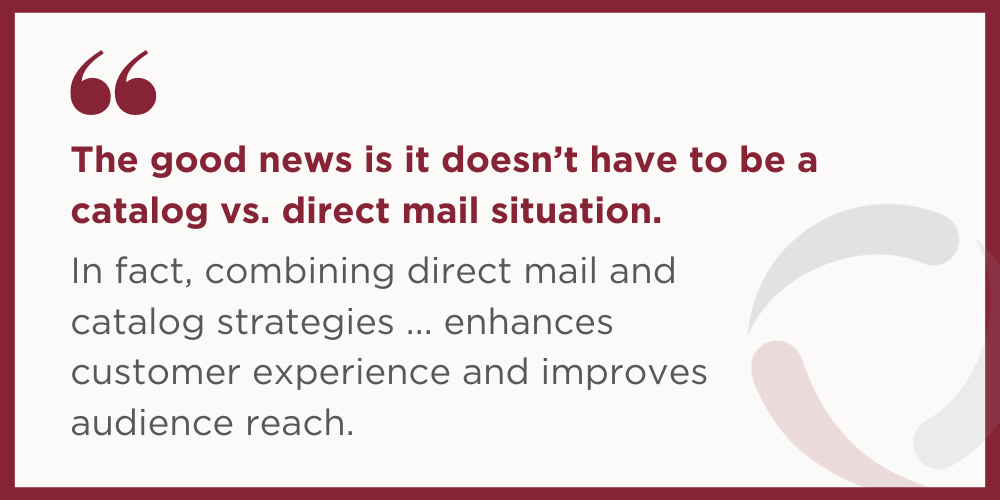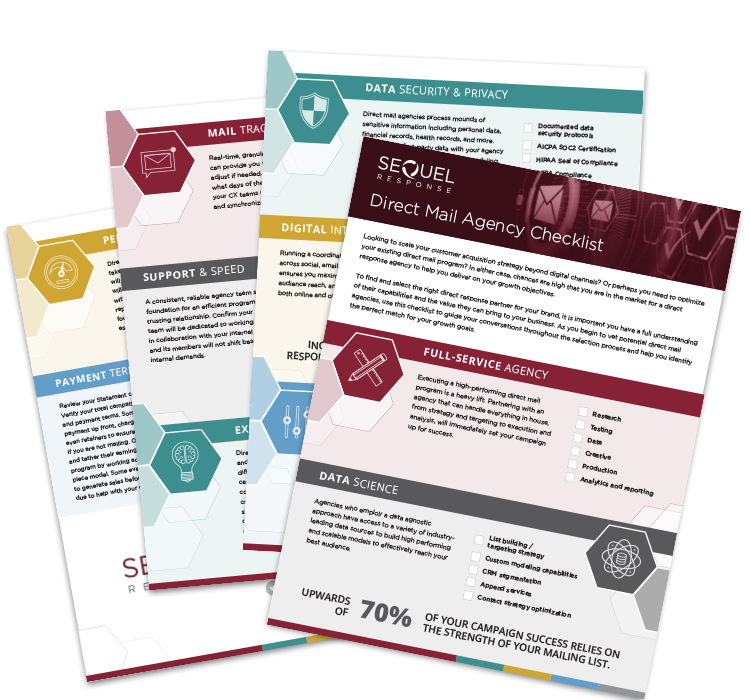Catalogs vs. Direct Mail: Tips to Maximize Your Mail Performance

Today’s marketing showdown pins two popular forms of print marketing against one another: catalogs vs. direct mail. Some brands swear by catalog advertising, while others prioritize a stand-alone direct mail piece. In this article, we will compare these two types of mail and give tips on how to make your campaign better by using a strategy that combines their strengths.
|
Prefer to listen? Check out our podcast The Direct Effect: Catalogs vs. Direct Mail: Tips to Maximize Your Mail Performance |
Catalog Marketing
Catalogs are multi-page print advertisements that are mailed directly to individuals or a targeted audience. Catalogs are commonly used in the consumer goods industry for promoting clothing, home goods, beauty products, and more. Retail brands also distribute catalogs in-store and during events.
Catalogs can be printed up to 96 pages in length. This allows marketers to leverage long-form storytelling with plenty of space for product images, descriptions, pricing information, and even ordering instructions. Consumers enjoy catalogs because they can learn about the brand’s products or services in a visually appealing and informative way – on their own time.
When comparing catalog vs. direct mail costs, catalogs are an expensive print format (averaging $1+) due to the size and weight of each piece. This can make it difficult for brands with a limited mail budget or those who want to mail to a large audience. The production time required to design and produce catalogs can range from several weeks to several months, based on the complexity of the piece and the availability of design and production resources. And because consumers tend to keep catalogs for an extended period before making a purchase, attribution requires a long-game mindset.
Direct Mail Marketing
Yes, catalogs are considered a form of direct mail marketing. But for this article, direct mail marketing represents an individual piece of mail, such as a postcard, letter, or foldable self-mailer. Direct mail can be used by various types of industries to reach their target audience, including DTC, financial institutions, food and beverage, higher education, healthcare providers, nonprofit organizations, and more.
Direct mail offers flexible design and format options, allowing brands to customize mail pieces according to campaign objectives, target audience, and budget. Marketers can choose from a variety of sizes and formats based on campaign goals, including letters, postcards, brochures, fold-out cards, and even multi-page booklets. The most common direct mail campaigns can be classified as marketing mail and are designed for automated processing and sorting by mail-handling machines. In general, direct mail costs are half that of catalogs, averaging $0.50 per piece.
Direct mail campaigns are known to produce a healthy ROI. Industry research shows that 78% of consumers prefer direct mail postcards over other popular mail formats, including catalogs. This could be because individual mail pieces feel more personal to the recipient than a one-size-fits-all catalog, or because direct mail is quickly digestible, and visible call-to-actions make conversion expectations clear.
Tips to Maximize Your Catalog and Direct Mail Performance

The good news is it doesn’t have to be a catalog vs. direct mail situation. In fact, combining direct mail and catalog strategies can create a powerful unity that enhances customer experience and improves audience reach.
Catalogs and direct mail both provide a unique tactile experience. Catalogs allow your audience to immerse themselves in your brand and products. Direct mail feels like a personalized invitation to engage with your brand. Together, they deliver a seamless offline experience that caters to different audience segments and decision-making stages.
We suggest using catalogs for your CRM and retention programs.
The long-form catalog format is a great way to feature new products during each season or boost excitement about upcoming items. Catalogs also have a higher perceived value, making existing customers feel appreciated for their continued loyalty. This increases their likelihood of engaging and completing a purchase in the future. Leveraging your first-party data when building mailing lists will protect your postage budget from the considerable costs associated with high-volume acquisition mailings.
For your prospecting and acquisition mail programs, we recommend leveraging direct mail.
Our industry research has found marketers choose direct mail over other channels for customer acquisition campaigns. The ANA Response Rate Report metrics align, showing 67% of marketers use letter-sized envelopes and 62% use postcards when mailing prospect lists. The variety of mailing list sources available allows you to build targeted mailings based on customer preferences and purchasing behavior that will resonate with your prospective buyers. With variable printing data, direct mail pieces can include personalized elements for each individual on your mailing list. Lastly, print, production, and postage expenses for direct mail are considerably lower than catalogs because they use less material. This will translate to significant savings when mailing to large audiences.
How to Optimize Your Catalog and Direct Mail Budget
Above we discussed how you can use catalogs for retention and direct mail for prospecting to optimize your direct mail budget, but we still have a few more tricks up our sleeve. If you’re looking for a best-of-both-worlds format that blends a catalog and direct mail piece, we recommend a mini-book.
Catalog marketers looking to preserve costs often mail mini-books, or booklet mailers, due to their compact size and format flexibility. Mini-books are available in 6-36 page lengths and are typically folded along the spine and sealed with tabs or a flap. Because they are smaller than traditional catalogs, they qualify for reduced postage rates of 30% or more when compared to catalogs.
The creative versatility available to mailers is another reason mini-books are an appealing option. As a long-form format, they provide ample space for copy, images, and brand messaging to effectively communicate with your audience. Busy consumers love booklets because they feel posh yet concise, increasing overall engagement with your mailer.
Catalog vs. Direct Mail Case Study
An online home furnishing retailer tested a 12-page mini-book against a trifold self-mailer, targeting prospect records. The mini-book was approximately 50% more expensive, but it led to a 20% growth in sales and revenue over the trifold. Given the higher cost, the mini-book yields a lower Return on Ad Spend (ROAS) and a higher Cost Per Acquisition (CPA).
Some brands may look for efficiency while others chase the highest number of sales. This data suggests that prospects respond well to a more engaging, long-form creative, but it may not be enough to outrun the incremental cost.
_____
Marketers agree the top advantages of the mail channel are the flexible volume, budget, and format options. Rather than settle for the catalog status quo, regularly test your control format against new and innovative direct mail designs. Challenging performance with a strong testing strategy can enhance your customer acquisition and retention programs for an improved campaign ROI.
Ready to get started? Contact a SeQuel strategist today.

